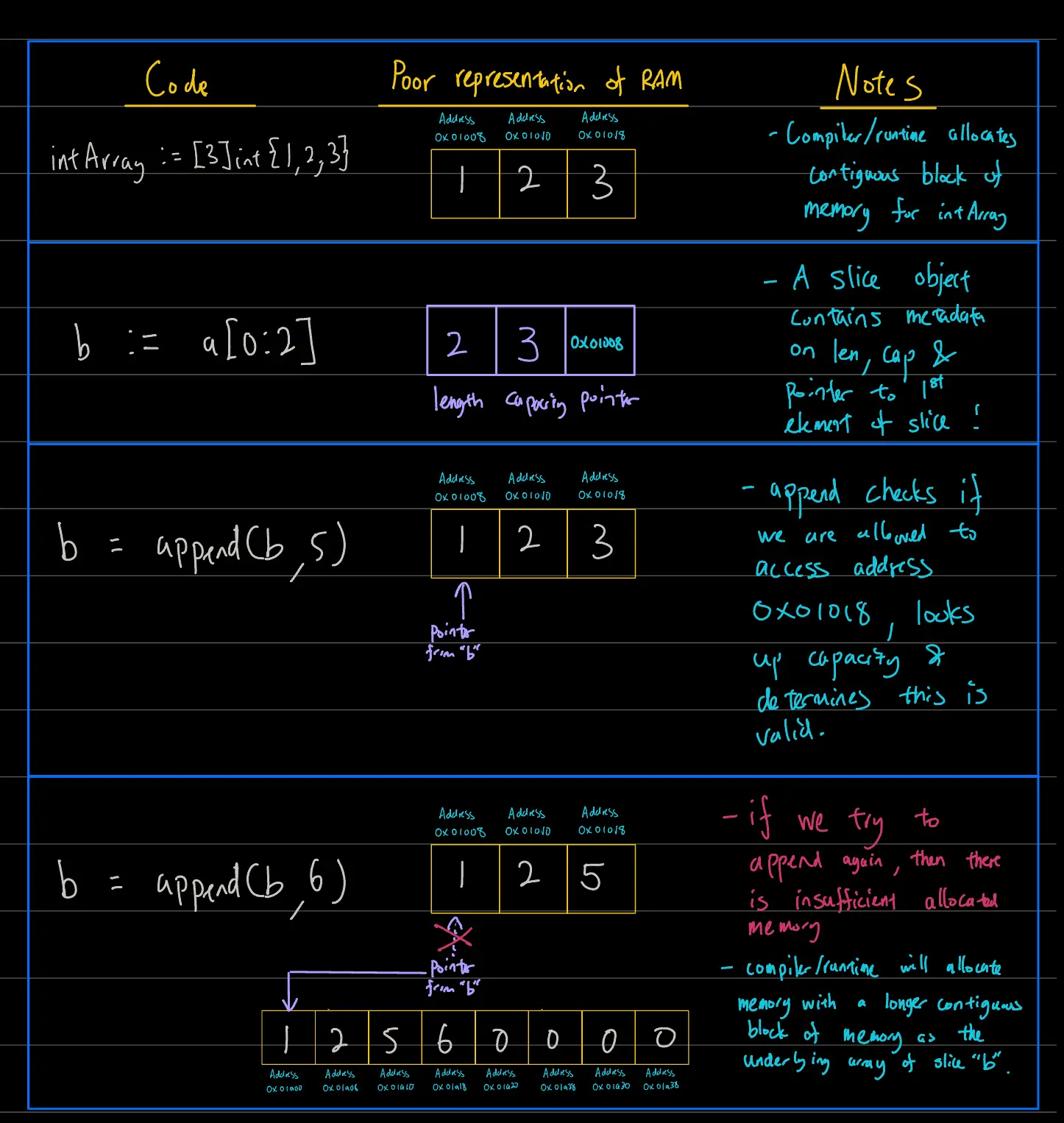
Learning Golang: Growing Pains
-
- Golang |
- 01 Feb, 2025 |
- 03 Mins read
Golang is a breath of fresh air coming from JavaScript
I like that it is opinionated.
It’s as if a minimalist looked at C and just threw away as much things as possible.
But it does come with it’s own set of problems..
Colour me unimpressed, 2 to 3 weeks into learning golang, when I found out about slices.
Here are some footguns pertaining to slices.
Problem 1a
package main
import "fmt"
func main() {
a:= []int{1,2,3} // slice "a"
b:= a[0:2] // slice "b" is a subslice of slice "a"
fmt.Println(a)
fmt.Println(b)
}
[1 2 3]
[1 2]
So far so good
Let’s try to change 2nd element of slice “b”
package main
import "fmt"
func main() {
a:= []int{1,2,3} // slice "a"
b:= a[0:2] // slice "b" is a subslice of slice "a"
b[1] = 5 // We introduce this line of code
fmt.Println(a)
fmt.Println(b)
}
[1 5 3] <-- we expected [1 2 3]
[1 5] <-- we expected [1 5]
uh oh.
we’ve accidentally changed slice “a” while changing slice “b”.
Solution 1a
“Slices are like references to array” - Tour of Go
When in rome, do as the romans do!
When writing golang, go as the gophers go!
i.e. this is a feature not a bug!
Problem 1b

package main
import "fmt"
func main() {
a:= []int{1,2,3} // slice "a"
b:= a[0:2] // slice "b" is a subslice of slice "a"
b = append(b, 5) // We changed this line
fmt.Println(a)
fmt.Println(b)
}
Wanna guess the output?
Click to reveal!
output
[1 2 5]
[1 2 5]
Let’s explore problem 1b
It turns out slices have a hidden feature!
To show you, let’s initialize slices using make()
package main
import "fmt"
func main() {
slice1 := make([]int, 5) // initialize slice with length 5
slice2 := make([]int, 0 , 5) // initialize slice with length 0 and 5 of something???
fmt.Println(slice1)
fmt.Println(slice2)
}
output
[0 0 0 0 0]
[]
huh? what’s with the 3rd argument of make?
according to Tour of Go this is the capacity of a slice!
meaning make([]type, length, capacity)
so… let’s answer 2 questions
1. Why did compiler/runtime not assign new memory address to appended subslice (i.e. the new slice “b”)
Remember that slices are references to underlying array?
“b” has a capcaity of 3, because that’s how much memory we can store in the underlying array!
Confused? let me demonstrate with a drawing.

2. Why did it overwrite slice a?
Refer to problem and solution 1a!
Solution 1b
So the solution… depends on what your are trying to acheive.
For the times you don’t have to deal with capacity
let me introduce a better way to slice.
package main
import "fmt"
func main() {
intArray := [3]int{1,2,3}
b := intArray[0:2:2] // change here
}
fmt.Printf("Length: %d, Capacity: %d, Slice: %v\n", len(b), cap(b), b)
Length: 2, Capacity: 2, Slice: [1,2]
For the other times..
-
Allocate mental overhead (so punny) to conscientiously handle slice capacity.
-
Don’t have multiple slices pointing to the same underlying array.. that’s just asking for trouble
Slice problem 1c
Hey I thought we were done with problem 1.x ???
Because capacity itself opens another can of worms..
package main
import "fmt"
func main() {
intArray := [5]int{3,1,4,1,5} // we create an int array
a:= intArray[:3] // "a" will be a subslice of intArray
fmt.Printf("Length: %d, Capacity: %d, Slice: %v\n", len(a), cap(a), a)
// magic happens here
a = a[:5]
fmt.Printf("Length: %d, Capacity: %d, Slice: %v\n", len(a), cap(a), a)
}
Length: 3, Capacity: 5, [3 1 4]
Length: 5, Capacity: 5, [3 1 4 1 5]
whoa.. we can restore length by reslicing!
folks, stay seated.. the performance is not over
package main
import "fmt"
func main() {
intArray := [5]int{3,1,4,1,5} // we create an int array
b:= intArray[2:5] // "b" is also a subslice of intArray
fmt.Printf("Length: %d, Capacity: %d, Slice: %v\n", len(b), cap(b), b)
// HUH? no magic here???
b = b[0:]
fmt.Printf("Length: %d, Capacity: %d, Slice: %v\n", len(b), cap(b), b)
}
Length: 3, Capacity: 3, [4 1 5]
Length: 3, Capacity: 3, [4 1 5]
Apparently, slicing from the front reduces capacity..
Solution 1c
Building on solution 1b.
Capacity is not just the length of the underlying array.
Perhaps we can think about it as the number of available spaces from pointer address to end of array.
Problem 2
(Work in progress) Reading vs writing empty slice